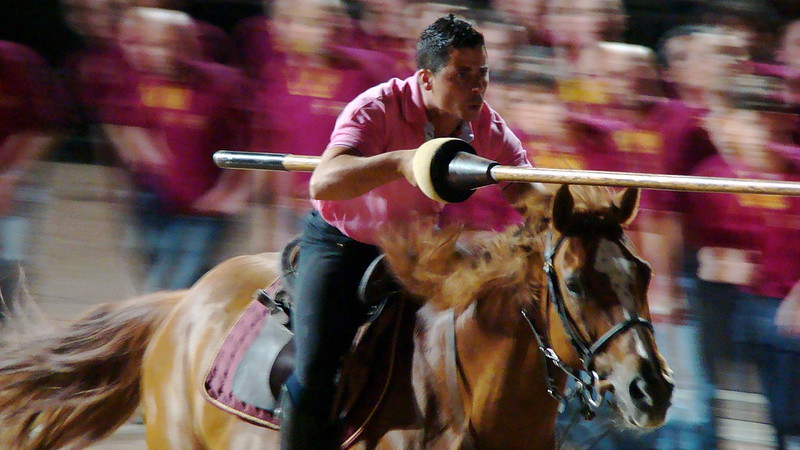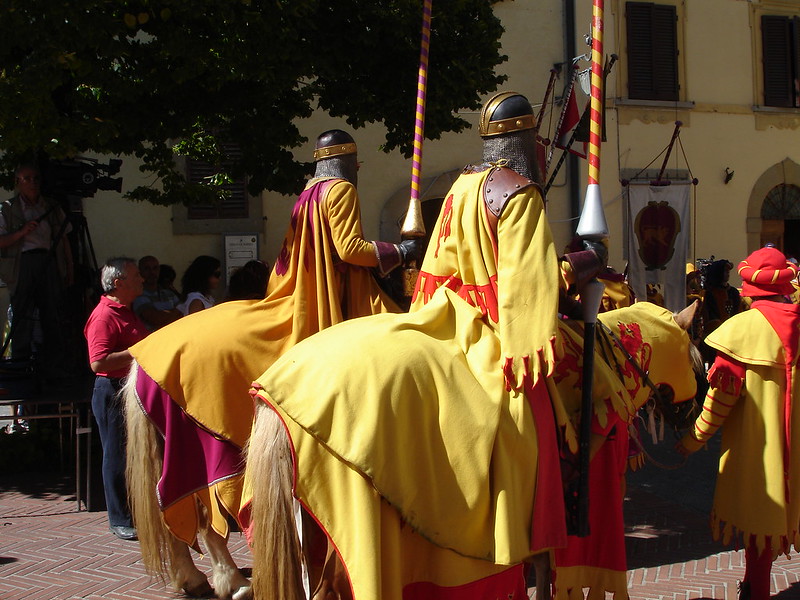Giostra del Saracino
Medieval Chivalry Revived in Arezzo's Grand Piazza
2022/06/24 - 2022/09/03
Twice a year, the ancient town of Arezzo transforms into a living medieval tapestry. This thrilling jousting tournament, known as the Giostra del Saracino, takes place in the magnificent Piazza Grande, where the city's four districts compete in skill, courage, and centuries-old tradition. The thundering of hooves and the clash of lances against shields echo through the square. Spectators are transported back to medieval Italy, experiencing the raw excitement and pageantry of the festival.
Main Attractions
The Breathtaking Joust
The highlight of the Giostra del Saracino is undoubtedly the jousting tournament itself. Eight knights, representing the four districts of Arezzo, compete on the specially constructed "Lizza" course in Piazza Grande. This 75-meter dirt track becomes the stage for a display of breathtaking speed and skill.
The knights' target is the "Buratto," a wooden effigy representing the King of India, positioned at the end of the course. With lance in hand, the knights charge at full gallop, captivating the audience. Their goal is to strike the Buratto's shield accurately. However, they must also avoid the rotating club in the Buratto's other hand, which can result in a penalty if struck. The knights must time their moves perfectly.
With each resounding hit of lance on shield, the square erupts in cheers or groans. The knights' bravery, the audience's fervor, and the centuries-old tradition combine to create a truly spectacular scene.
The Timeless Procession
The jousting tournament is preceded by a magnificent procession that seems to transport Arezzo back in time. The city is instantly transformed into its medieval self. Over 300 participants in period costumes line the cobblestone streets from the Cathedral to Piazza Grande. Leading the procession is the official musical group, "Gruppo Musici." The rhythmic beats of drums and clear trumpet notes resound through the quiet streets. Flag bearers perform intricate routines, their colorful banners adorned with the emblems of Arezzo's four districts dancing against the blue sky.
As the procession approaches, all five senses are heightened. The rustle of silk and velvet costumes in the wind, the glint of polished armor, the clip-clop of horses' hooves on ancient cobblestones. There's a unique scent of leather, metal, and perfume in the air. The expressions of the participants passing by convey the pride and passion they hold for this festival.
This procession is not merely a prelude. For the people of Arezzo, it's a crucial ritual embodying their history and traditions. Spectators, too, find themselves drawn into what feels like a scene from the Middle Ages, gradually enveloped by the festival's fervor.
Tuscan Cuisine: Local Flavors Enhancing the Festival
The Giostra del Saracino is not only a competition carrying on medieval traditions but also a celebration of Tuscan cuisine. As the festival approaches, the streets of Arezzo fill with the aromas of local specialties.
Visitors should first try "Ribollita," a signature Tuscan dish. This soup, made with black cabbage, beans, and aromatic vegetables, then re-cooked with stale bread, lives up to its name meaning "reboiled." It's a humble yet deeply flavorful dish, perfect for warming both body and soul in cooler weather. For meat lovers, "Peposo" is recommended. This beef stew, slow-cooked with plenty of black pepper and wine, is said to have been the source of strength for the stonemasons who built the cathedral. The spicy aroma and tender meat texture create a perfect harmony on the palate.
On the eve of the festival, each district hosts a "Cena Propiziatoria," a good luck feast. Locals and tourists gather to enjoy traditional dishes while anticipating the next day's competition. The tables are laden with local delicacies such as pappardelle pasta with wild boar ragout and "Arrosticini," a Tuscan-style roast.
Essential to these meals is Chianti wine, the pride of Tuscany. The robust red wine not only complements the food but also enhances the festive atmosphere. As the wine flows, heated discussions about the next day's competition and the skills of each district's knights ensue. This feast is truly a gastronomic prelude to the festival, with participants' expectations and excitement reaching a fever pitch for the upcoming spectacle.
Cultural and Historical Background
The Giostra del Saracino that colors the streets of Arezzo is not merely a tourist event. It is a tradition that has been passed down since medieval times and is the very identity of the people of Arezzo. The origins of this festival date back to 1535. Initially, it began as training for knights heading to the Crusades, with the format of striking a target modeled after a "Saracen" with a lance. This was designed to simulate the enemies the knights would face on the actual battlefield.
Over time, this competition has undergone transformation. From its origins as military training, it has evolved into a grand festival showcasing Arezzo's prosperity, power, and the courage of its citizens. Currently, it is held twice a year, in June and September, and has become the most important event in Arezzo's cultural calendar.
The heart of the Giostra del Saracino is the competition between Arezzo's four districts (Porta Crucifera, Porta del Foro, Porta Sant'Andrea, and Porta Santo Spirito). Each district has its own unique history and traditions, which are vividly reflected in their emblems, flags, and costumes. For example, the red and green of Porta Crucifera and the red and yellow of Porta del Foro express the pride of each district.
The sense of belonging to a district is very strong and is passed down through generations in many families. Children learn about their district's history and traditions from a young age and participate in festival preparations, fostering a sense of community membership. The outcome of the competition holds more meaning than just a sporting result. Victory becomes a source of district pride, while defeat serves as motivation for the following year.
Furthermore, the Giostra del Saracino is also a venue for preserving artistry and craftsmanship. The creation of magnificent costumes, flags, and the "Golden Lance" victory trophy involves the exceptional skills of local artisans. These works embody Arezzo's rich artistic traditions and are carefully preserved across generations.
Thus, the Giostra del Saracino is a living bond connecting the past and present for the people of Arezzo, and an important cultural foundation shaping their identity. This biannual festival is an invaluable opportunity to celebrate Arezzo's rich history and reaffirm the strong bonds of the community.
Participant Voices
On a day trip from Florence to Arezzo, I stumbled upon the Giostra del Saracino by chance. It turned out to be an unexpected treasure and became the highlight of my Italian journey. While Arezzo is usually a quiet town, on this day the air was electric, as if the entire city was trembling with excitement. I found myself caught up in the fervor, cheering alongside the locals. I fell in love with the vibrant red and green colors at first sight. When the jousting tournament began, the tension was so palpable I almost forgot to breathe. Every time a knight thundered down the track at full speed, my heart was racing. But what left the deepest impression was the warmth of the local people. An elderly gentleman sitting next to me must have noticed my confusion. He explained the rules and history of the festival to me as if he were telling a story to his grandchild. Touched by this kindness, I found myself blending into the atmosphere of Arezzo before I knew it. Before I realized it, I had even bought a scarf. Wearing it makes me feel like I've become a part of this city. This unexpected encounter with a passionate festival and the warmth of its people in the small town of Arezzo will surely become an unforgettable memory for me.
Fun Facts
- Dante Alighieri, Italy's renowned poet, mentions Arezzo's jousting tournament in his immortal masterpiece "The Divine Comedy." Written between the late 13th and early 14th centuries, this reference has firmly established the Giostra del Saracino in Italian literary history. Through Dante's pen, this traditional event has transcended being merely a local festival to become recognized as an important part of Italian culture.
- The horses used in the competition undergo over a year of special training to cope with the unique challenges of Piazza Grande's slope and uneven surface.
- In 1677, the Grand Duke of Tuscany himself participated in the Giostra del Saracino, demonstrating the high prestige this event held even among the nobility.
Festival Dates
The Giostra del Saracino is held twice a year in Arezzo's Piazza Grande.
The event schedule is subject to change. Please check the official website for the most up-to-date information.
Information
| Name | Giostra del Saracino |
| Country | Italy |
| Area | Arezzo |
| Date | 2022/06/24 - 2022/09/03 |
| Link |
Upcoming Festivals
Whirling Dervishes Festival Turkey
A Mesmerizing Dance of Divine Love
2025/12/06Mevlana Celaleddin Rumi Commemoration Ceremony ( Şeb-i Arus ) Turkey
A Whirling Journey to Divine Love
2025/12/10Dia de la Virgen de Guadalupe Mexico
A Festival Weaving Faith, Fervor, and Mexican Identity
2025/12/11L'Escalade Switzerland
Geneva’s Grand Winter Festival of Courage, Chocolate, and Community
2025/12/12Umkhosi Wokweshwama South Africa
The Zulu First Fruits Festival—A Sacred Celebration of Land, Ancestors, and Renewal
2025/12/12Lucia Festival (St. Lucia's Day) Sweden
A Festival of Light Illuminating the Nordic Darkness
2025/12/15Las Posadas Mexico
The Luminous Quest for Sacred Shelter
2025/12/22Noche de Rabanos (Night of the Radishes) Mexico
A celebration blending art, farming heritage, and cultural traditions
2025/12/23Chant of the Sybil on Majorca Spain
A Medieval Prophecy Echoes Through Majorcan Christmas
2025/12/23‘Hatajo de Negritos’ and the ‘Hatajo de Pallitas’ Peru
A Christmas Festival of Rhythm, Faith, and Afro-Andean Heritage in Peru’s Ica Region

